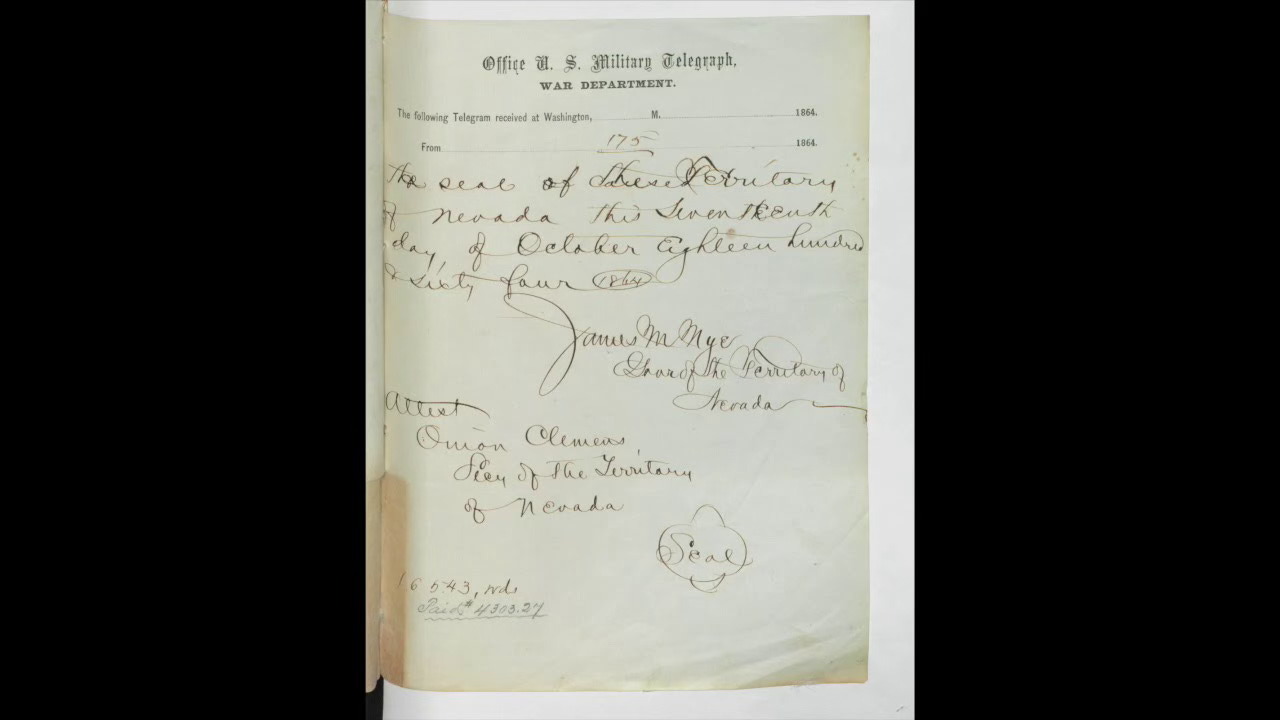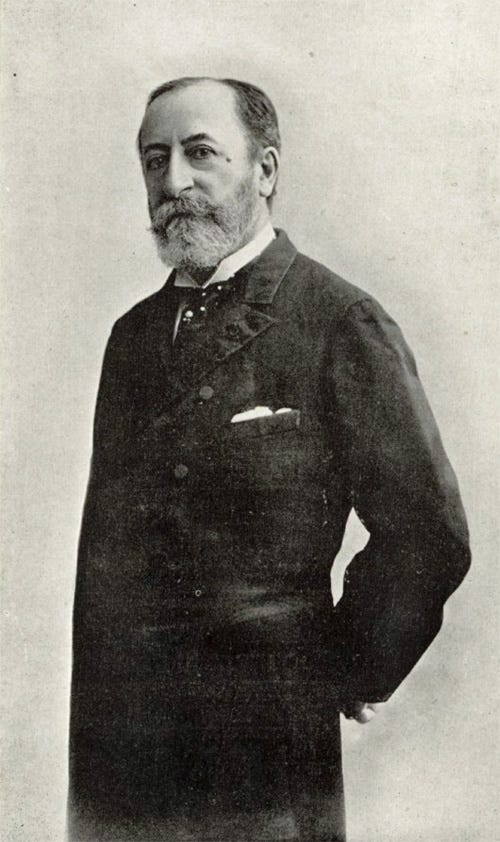This Day in Legal History: Nevada Admitted as 36th State
On October 31, 1864, Nevada was officially admitted as the 36th state of the United States, a move driven as much by wartime politics as by the territory’s readiness for statehood. With President Abraham Lincoln seeking re-election and needing support for the proposed 13th Amendment to abolish slavery, the Republican-controlled Congress saw strategic value in adding another loyal Union state. Although Nevada’s population was below the threshold typically required for statehood, its vast mineral wealth and political alignment with the Union helped accelerate the process. To meet the tight timeline ahead of the 1864 election, Nevada’s leaders moved quickly to draft a state constitution.
Facing logistical challenges in sending the document from Carson City to Washington, D.C., Nevada officials made the unprecedented decision to transmit the entire text—over 16,000 words—via telegraph. The transmission took over 12 hours and cost more than $4,000, making it the longest and most expensive telegram ever sent at the time. The decision proved effective: the telegram reached the capital in time, and Congress formally approved Nevada’s admission on the same day.
The speed and cost of Nevada’s telegraphic constitution became a symbol of the urgency and improvisation of Civil War-era governance. The state’s motto, “Battle Born,” reflects both its literal birth during the Civil War and the political battle over slavery and Union preservation. Nevada’s admission also helped secure support for Lincoln’s re-election and for the 13th Amendment, which passed Congress in January 1865.
In a recently disclosed legal filing, Immigration and Customs Enforcement (ICE) sought taxpayer information on over 1.28 million individuals from the IRS, though only about 47,000 records matched. The request, part of a broader effort to access data on individuals under final removal orders, was submitted under a carve-out in Section 6103 of the Internal Revenue Code, which permits limited disclosures during criminal investigations. The IRS initially rejected ICE’s requests citing legal constraints, but a memorandum of understanding in April allowed for limited data sharing. A subsequent refined request from ICE in June targeted a smaller group of 1.27 million, but again, only a small percentage matched IRS records, and many failed to meet legal standards for processing.
The case arose from a lawsuit filed by taxpayer advocacy groups and unions, which argue that these disclosures violate the Tax Reform Act, the Privacy Act, and the Administrative Procedure Act. Plaintiffs are seeking a preliminary injunction to halt further sharing. Internal emails reveal IRS officials were concerned about the unprecedented scale and legality of the request, and officials emphasized the need to keep the data sharing confidential. The IRS typically handles about 30,000 such data requests a year, each requiring detailed justification and high-level agency approval. Critics warn that this massive data handover poses urgent threats to taxpayer privacy and due process rights.
ICE Sought Records on 1.3 Million Taxpayers, Filing Shows (1)
U.S. District Judge Carl Nichols praised two federal prosecutors, Samuel White and Carlos Valdivia, for their handling of a case against Taylor Taranto, despite both being suspended by the Justice Department the day before. The suspension followed their reference to January 6 rioters as “a mob of rioters” and mention of Donald Trump allegedly sharing Barack Obama’s address in a sentencing memo. Judge Nichols commended their work as professional and exemplary, stating they upheld the highest prosecutorial standards.
Taranto was sentenced to 21 months in prison for firearm and hoax-related charges after being arrested near Obama’s D.C. residence in 2023. However, he will not serve additional time due to pretrial detention. Though originally charged for participating in the Capitol riot, those charges were dropped under President Trump’s mass clemency order for January 6 defendants issued at the start of his second term. Taranto’s defense claimed his statements about explosives were meant as “dark humor” and that he hadn’t committed any violence.
After White and Valdivia’s suspension, a revised sentencing memo—stripped of January 6 and Trump references—was filed by two replacement prosecutors, including a senior DOJ official. The incident reflects broader tensions under the Trump administration, which has repeatedly moved to minimize references to Capitol riot violence and penalize prosecutors involved in politically sensitive cases.
US judge praises prosecutors who were suspended after referring to January 6 ‘mob’ | Reuters
A federal judge allowed the Trump administration to move forward with firing nearly all remaining employees of the Department of Justice’s Community Relations Service (CRS), an agency established in the 1960s to mediate racial and ethnic conflicts. U.S. District Judge Indira Talwani, while denying a temporary restraining order sought by civil rights groups, noted that the plaintiffs failed to show immediate, irreparable harm. However, she also stated that the groups are likely to succeed in proving that the executive branch cannot lawfully dissolve a congressionally created agency.
The lawsuit, brought by 11 organizations including the NAACP and the Ethical Society of Police, challenges the Justice Department’s recent “reduction in force” that would leave just one CRS employee. The move follows a pattern under the Trump administration, which has rejected all new requests for CRS services and proposed no funding for the agency in its budget. Plaintiffs argue that a termination notice stating the layoffs aim to “effectuate the dissolution” of CRS confirms unlawful intent.
Although Talwani’s ruling allows the firings to proceed, she emphasized that the final outcome may favor the plaintiffs as the case continues. The layoffs coincide with a government shutdown that began October 1, meaning the employees would have been furloughed regardless. The DOJ claims it is merely reorganizing, not eliminating, the agency, though it concedes that only Congress has the authority to formally abolish it.
Judge allows Trump administration to fire most of DOJ race-relations agency’s employees | Reuters
Hagens Berman Sobol Shapiro, a prominent plaintiffs’ law firm, is under scrutiny in two high-profile class actions, facing judicial criticism and potential sanctions. In Seattle, a federal judge sanctioned the firm for over $223,000 after finding it misled the court and opposing counsel about its client’s withdrawal from an antitrust case against Apple and Amazon. The judge said Hagens Berman failed to disclose that their client, who later disappeared from proceedings, had expressed his intent to exit the case months earlier. The firm argues it acted ethically under client confidentiality rules and has asked the judge to revise her dismissal ruling.
In a separate matter in Philadelphia, the firm faces possible new sanctions in long-running litigation over thalidomide-related birth defect claims. A special master found misconduct, including altering an expert report and advancing claims lacking legal merit. While Hagens Berman disputes the findings, calling them outside the master’s authority and biased, U.S. District Judge Paul Diamond upheld the report. The firm has now requested that Diamond recuse himself, citing an appearance of bias due to his close coordination with the special master.
In both cases, Hagens Berman maintains its actions were in good faith and within legal and ethical bounds, while critics and courts point to patterns of misrepresentation and overreach.
Law firm Hagens Berman battles sanctions in Apple, thalidomide cases | Reuters
This week’s closing theme is by Camille Saint-Saëns.
Camille Saint-Saëns was a French composer, organist, conductor, and pianist whose long career spanned the Romantic era and touched the early 20th century. Born in Paris in 1835, he was a child prodigy who began composing at the age of three and gave his first public performance at ten. Saint-Saëns was celebrated for his extraordinary versatility, writing symphonies, concertos, operas, chamber music, and choral works. Though deeply rooted in classical forms, he was an early supporter of contemporary composers like Liszt and Wagner, even as he remained skeptical of more radical modernism. His music often combined technical brilliance with elegance, and his clear, structured style made him a bridge between tradition and innovation. He was also a prolific writer and amateur astronomer, and his intellectual breadth sometimes earned him criticism from those who found his music too refined or academic. Still, Saint-Saëns maintained influence across Europe, and his works remain staples of the concert repertoire.
This week’s closing theme is Saint-Saëns’ Danse Macabre. Originally a song for voice and piano based on a poem by Henri Cazalis, Saint-Saëns later reworked Danse Macabre into a tone poem for orchestra. It depicts Death summoning the dead from their graves at midnight on Halloween for a wild, skeletal waltz. A solo violin—tuned unconventionally to evoke a harsh, eerie sound—plays Death’s dance theme, while xylophone rattles mimic clacking bones. The piece was controversial at its premiere in 1875 but quickly became a concert favorite, especially around Halloween. With its vivid orchestration and playful macabre imagery, Danse Macabre is one of classical music’s most iconic musical depictions of the supernatural, perfectly capturing the spirit of the season.
Without further ado, Saint-Saëns Danse Macabre—enjoy!














